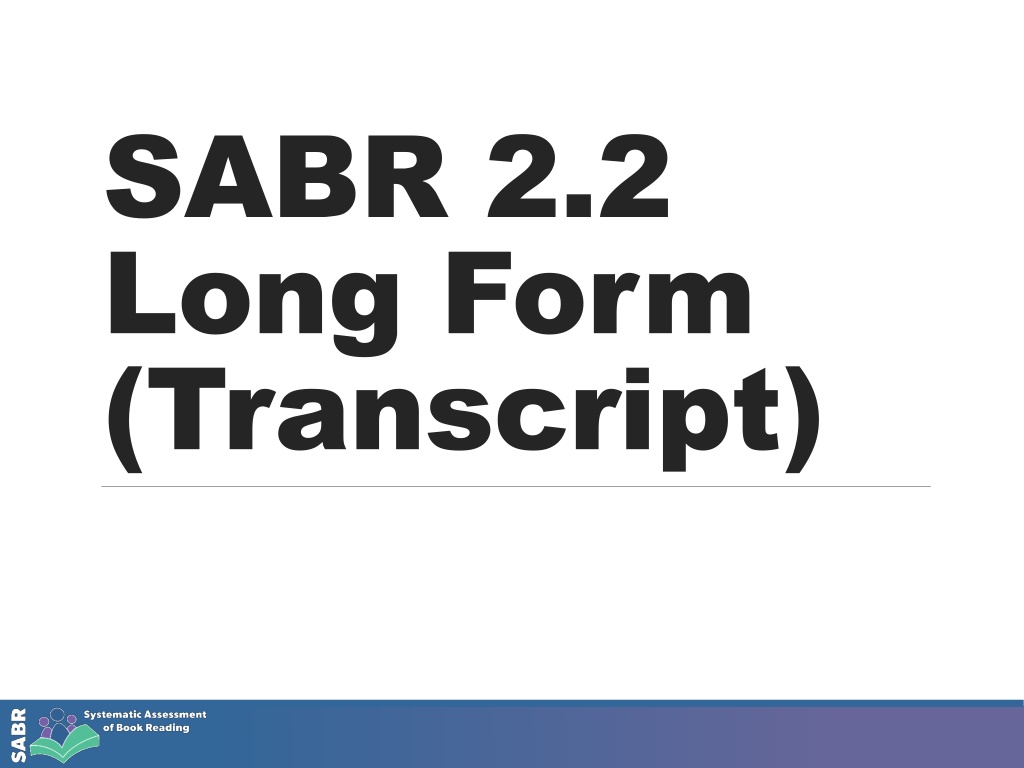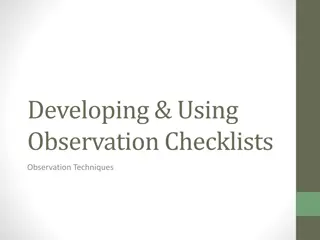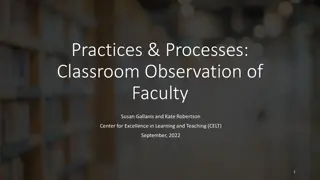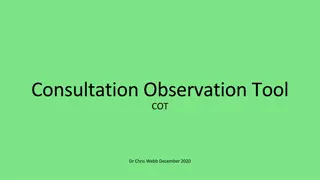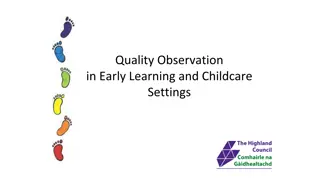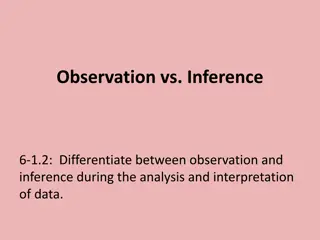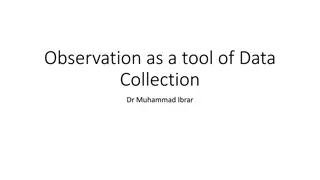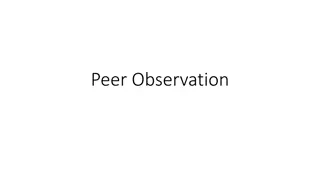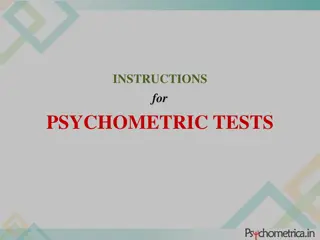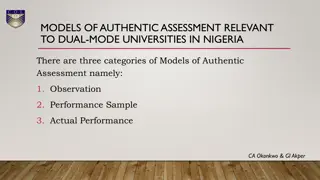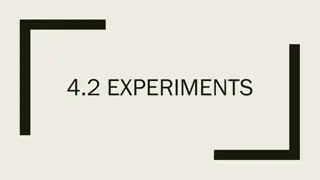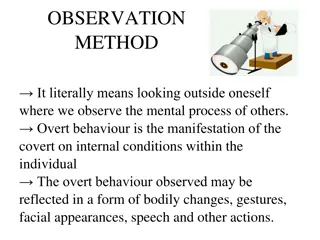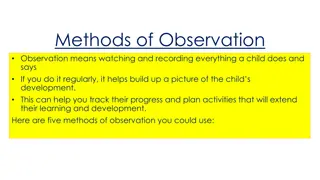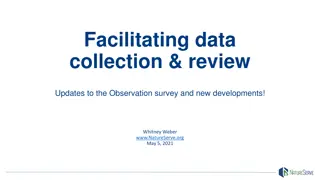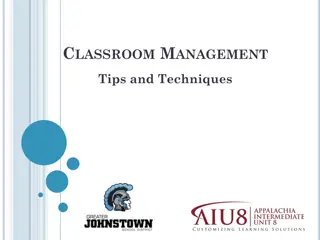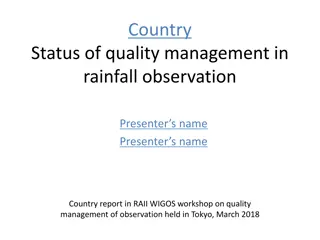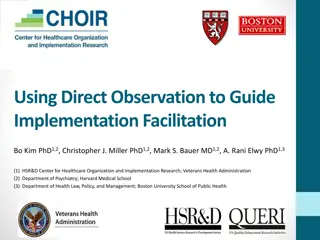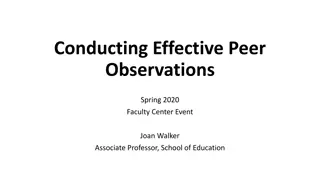Understanding SABR Tool for Effective Classroom Observation
The SABR tool is a valuable instrument funded by the U.S. Department of Education to assess teacher and child interactions during shared book reading in classrooms. It focuses on behaviors that enhance language and literacy skills in young children, aligning with national and state standards. The tool categorizes various types of talk counted and not counted, providing detailed codes for behavior, literacy, and meaning analysis.
Download Presentation

Please find below an Image/Link to download the presentation.
The content on the website is provided AS IS for your information and personal use only. It may not be sold, licensed, or shared on other websites without obtaining consent from the author. Download presentation by click this link. If you encounter any issues during the download, it is possible that the publisher has removed the file from their server.
E N D
Presentation Transcript
SABR 2.2 Long Form (Transcript)
About SABR The SABR tool examines qualities of teacher and child talk through observation of classroom shared book reading. Developed with funding from the U.S. Department of Education, Institute of Education Sciences, the SABR is a reliable and valid measure of classroom quality. The tool captures the frequency of key behaviors that are known to promote young children s language and literacy skills. The system is well aligned with the national learning standards and state standards for pre-kindergarten through grade 1 levels. It can be used by teachers, school leaders, and intervention specialists to promote effective teaching. Form Behavior Literacy Meaning
Overview: Types of Talk Counted CHILD TEACHER Timing of the talk Recasts, extensions in response to C talk Questions Behavior-related Literacy-related Meaning-related Special terms Timing of the talk Comments Questions
Types of Talk NOT Counted Inaudible talk Transcriptionist indicated inaudible: XXX Abandoned thoughts: She . Too little content to code: I am XXX and XXX Filler words: Um, aww, oooh, wow Manners: Please, excuse me Yes/no teacher responses: Yes, no, yeah, nah, etc. Teacher praise: Great job!, Right! Exact repetitions: He s sad. He s sad. Activities beyond reading: Line up if you are wearing pink Talk in a language other than English
Full List of Codes and Speakers TEACHER CHILD Timing - Before During and After Form of utterance Repeat, Recast, Extend Length of answer required Question wording Answer known Behavior codes Redirections/Reminders Attention directing Teacher praise Literacy codes Book & Print Conventions Letters, Words, Writing Print meaning Author/illustrator Specific terms Sequence/Temporal Compare/contrast Meaning codes Meaning codes Cognition Define/Elaborate on Vocabulary Act Out & Pretend Play Feelings/Emotions Desires/Preferences Judgments/Perspectives Causal Effects Problem Solving Predictions/Forecasts Defining Vocabulary Making Connections Background Knowledge Act out and pretend play Timing - Before During and After Form of utterance Comments Questions Length of utterance Topic control Response accuracy Behavior Codes Redirections/Reminders Attention directing Teacher praise Literacy codes Book & Print Conventions Letters, Words, Writing Print meaning Author/illustrator Specific terms Sequence/Temporal Compare/contrast Meaning codes Meaning codes Cognition Define/Elaborate on Vocabulary Act Out & Pretend Play Feelings/Emotions Desires/Preferences Judgments/Perspectives Causal Effects Problem Solving Predictions/Forecasts Defining Vocabulary Making Connections Background Knowledge Act out and pretend play
Coding Decisions Coding teacher and Child talk Code talk related to reading (letters, words) and concepts of print (book handling) Exclude inaudible talk, filler words, and teachers yes no responses Determine form of utterance; Apply teacher question and child response codes Code talk exclusively related to managing behavior and bids for attention Code behavior-related talk embedded in meaning- and literacy- related talk Select general topic (Literacy, Behavior, Meaning) Code timing of the talk (before, during, after) Code specific terms Code talk related to literal and inferential levels of text comprehension
Goals By the end of this section, you will be able to: Distinguish between comments/directives and questions. Define various forms of questioning and other ways to elicit a response from a listener.
What is classroom discourse? Classroom discourse is a term for the language that teachers and students use to communicate within the classroom. This term includes several concepts: Patterns of conversation can be observed in most classrooms and are believed to shape the learning culture. Some approaches to learning (e.g., Socratic method) prize frequent questioning to actively engage students. Some approaches to learning (e.g., Constructivism) encourage open-ended, discovery questions for deeper learning. Other approaches to learning utilize questions to check student understanding throughout the lesson.
Comments and Directives Comments are a common form in which teachers and children impart information. These statements do not require a response and are typically designed to convey information. Comments are the most common utterance form. This is a lemonade stand.
Examples of Comments Teacher Comments Examples Comments are used to convey information Comments are used to make statements Comments do not demand a response from the listener. He is the king of the jungle. I will keep reading now. Yes, it is! Child Comments Comments are used to convey information Comments are used to make statements Comments do not demand a response from the listener Examples I see a dragon. They have the same pigeon book as us! Yes!
Examples of Directives Teacher Directives Examples Imperative sentences that issue orders Don t interrupt! Teachers often use Let s to gently imply a directive Directives require a response from the listener Let s make a prediction. Say this word. Child Directives Imperative sentences that issue orders Directives end with a period or exclamation mark Directives require a response from the listener Examples Give me a turn. Don t touch me! Show me which one.
Why did Petunia do that? Questions Question forms allow students to be more active participants. Teacher questions require a response from children. Questions come in many different forms: Auxiliary-Fronted Questions (yes/no questions) Yes/No Questions Turn-Taking Questions Basic wh- Questions Why Questions How Questions Children also elicit information by asking questions.
Question Modifiers Auxiliary-fronted questions An auxiliary verb (can, do, are ) is used at the beginning/front of a question A less formal question that does not include an auxiliary verb, but can be answered with yes/no Yes/No questions Basic wh- questions Who, what, when, where, which + interrogative sentence form Why questions Why + interrogative sentence form How questions How + interrogative sentence form Turn-taking questions Questions that give a child a turn to speak but don t fit another category
Examples of Questions Teacher/Child Questions Examples Auxiliary-fronted questions Do you know what this says? See the giraffe? The giraffe is tall, huh? Yes/No questions Basic wh- question What happened? Why question Why do you think that? How question How did they solve the problem? Turn-taking question Mason?
Answer Known They seek unknown information that the teacher does not already know. Child is asked for real/unknown/necessary information the adult does not have Could relate to children's feeling, preferences, desires, etc. Common topics that use real questions making a connection to child s life, predicting what will happen next, etc. They test the child s knowledge or understanding of a topic Have a known correct answer or parameters in which correct answers should fall. The purpose is to evaluate the child s response accuracy. These questions are of interest because they position the teacher as the primary knower. Real Questions Test questions
Examples of Real and Test Questions Teacher Questions Examples What is your favorite part? What do you think? Do you think he should forgive her? What color is that? Do you think this is make- believe? Which character is bossy? Real questions Test questions
Practice Yes/No Questions Put your thumb up if the question is an example of a Yes/No Q. You liked the book? Is that fair? Right, friends? See the pigeon? Are you ready? You see a girl?
Practice Turn-Taking Questions Put your thumb up if the question is an example of a Turn-Taking Q. What do you think, Max? Did you like the book, June? Penny? What did you say? Mason, how is Diego feeling? Yes, Clark?
Knowledge Check Distribute the Questions and Exclude Sorting Activity.
Focal Language Modeling Strategies Cloze Prompts Implicit prompt for child/ren to complete a sentence with a word or phrase. Recasts what a child says by providing a more complete/complex grammatical/syntactic model and/or more accurate meaning/semantics. Extensions and expansions add an idea or complexity to the child s idea.
Cloze Prompts These are implicit prompts for child/ren to complete a sentence with a word or phrase. Often includes rising intonation prompt at the end of the adult utterance to indicate to the child it is their turn to fill in the missing words. Adult can give a clue to the word by saying the initial sound or sounds in a word. You can still code the teacher s attempt to use this strategy, regardless of the children s responses.
Recasts Recasting is language modeling that uses at least one key word from the child s own utterance. A recast is a technique used in language teaching to correct learners' errors in a gentle way. The goal is to keep the conversation going (not obstruct communication). Think about the sequence of conversation. The teacher must use at least one of the child s important words to qualify as a recast. Other similar language modeling techniques are included such as repetitions and extensions of the child s utterance.
Examples Language Modeling Examples Cloze Prompts T: The king is tall, but the queen is (short) C: Look, watermelon! T: Watermelon. Repeat C: We goed to the park. T: We went to the park. Recast C: Nice dragon. T: She s pretending to be a nice dragon now. Expand
Practice Identifying Repeated, Recasted, or Extended Utterances Put your thumb up if you would code Repeat/Recast/Extend. T: What do you see on the cover? C: Blocks! T: Good. T: What else? T: Who s always the boss? C: Petunia. T: That s right. T: Petunia s always the boss when they play make-believe. C: There s a dragon! T: You see a dragon? C: He only got 1 color and she got 3. T: Oh, wow. T: That s not fair, is it? T: If she has 3 markers and Diego only has 1? T: What does pout mean? T: Mason? C: Crying. T: Sometimes you pout when you cry. T: So what does your face look like?
Length of Utterance Child Utterance Length Single word - generally contain a single word or a word + an article. Rote counting,self-correction, false startsin a single row, etc. Compound words are a single word. Examples C: The dragon. = Article + word C: /b/ = Letter sound C: Look, look. = Same word repeated C: 1, 2, 3, 4, 5 Multiple words generally contain two novel words or more. C:There s a lot of letters in this book. C: Mean bossypants. C:I know there s a lot of letters in this book because I know my ABCs. C: All night. C: Ice cream! Partially inaudible talk with at least two understandable words, singing songs, simple phrases, etc.
Topic Control Topic Control Child - Child controls the conversational topic or shifts the conversation to a new topic. Entirely new idea or a sub-topic Asking questions Consider immediately preceding utterance to help decide. Examples New topic T: I see lots of letters on this page. C:Look, I see a tiger s tail there! Child asks a question R: Petunia sulked off to the library. C: What does sulked mean? Teacher Child continues a topic presented by the teacher or responds to a teacher question. Responses to teacher questions/prompts, continuations of the teacher s earlier topics Child responds to teacher s question T: Jamora, why is she sulking and sad? C: Because they had a fight. Child response to cloze prompt T:Now they ll call it Kingdom of Fr C: Friends!
Response accuracy Response Accuracy Description Examples Accurate Fully correct or acceptable response to a teacher question T: What is this? [points to plane] C: A plane. Completely inaccurate or ambiguous response to a teacher Inaccurate T: What is this? [points to plane] C: A car. T:We don t fight like that, right? C:[no opportunity to respond] T: We use our words instead of kicking things. No response Students fail to respond or don t have an opportunity to respond to a question A child utterance does not follow a teacher question, the response accuracy is not applicable. Not Applicable T: This is silly. C: Bossypants is silly.
Behavior Considering the General Topic Literacy Meaning
Keywords Trump Context! However, follow this important rule when Behavior keywords co-occur with Meaning/Literacy keywords: Behavior keywords Literacy keywords Meaning keywords Code the Literacy or Meaning topics
Coding Modifiers Within the same general topic, modifiers can co-occur Meaning-focused utterance with multiple Meaning modifiers I think it s silly how Pigeon ended up loving the bath. Character Reference Desires/ Preferences Cognition Judgments/ Opinions Within the same utterance, topics can co-occur Literacy-focused utterance with Literacy and Meaning keywords Do you know what letter pigeon starts with? Letters/ Words/ Writing Cognition
Goals By the end of this module you will be able to: Identify ways that teachers talk about book and print conventions during read-alouds Identify places where teachers reference letters, words, and writing during read-alouds
What is print meaning? Print meaning is an umbrella term that includes young children s earliest understandings that print and written language carry meaning. This term includes several concepts: Print carries meaning that differs depending on the context, such as story with words or a road sign for safety. Print and books are organized in ways that follow particular rules, such as moving form left to right and on a page. Print is made of letters that each have their own name, shape, and sound(s) associated with them. Words can be written down to convey a message. When you put letters together you make words. Writing is a means for conveying language. Talk about reading helps children understand the cognitive processes involved in decoding written language.
Key Instructional Targets Print Meaning Author/Illustrator Book and print conventions Letters Words Writing
Print Meaning Function of print as a meaningful symbol, including the metacognitive process of thinking about how/why we read Talk about how print carries meaning (that is distinct from pictures) Things you do when you read Why we read books Talk about desires or preferences for reading
Examples of Print Meaning Types of talk Examples T: I have to read the words to understand the story. Print carries meaning Things you do when you read the act of reading T: What is the first thing I do when I want to read a story?
Author/Illustrator Talk that names the author/illustrator or discusses the role of the author/illustrator. Naming the author or illustrator (must be more than simply reading the names Discussing the role of the author or illustrator
Examples of Author/Illustrator Types of talk Examples T: Mo Willems wrote this book. T: A man named Matt Dye drew the pictures. Naming the author/illustrator Discussing the role of author/illustrator T: Who writes the words? C: The author!
Book and Print Conventions How to use books Turn pages Manipulate the book Name parts of the book (cover, spine, etc.) Directionality of print in English moves from left to right and we read from top to bottom Name parts of the story (beginning, middle, end) Name or explain the title Name the genre
Examples of Book and Print Conventions Types of talk Examples T: What is this part of the book called? T: That s the spine/cover of the book. Talk about parts of the book Describe how print in English moves from left to right, etc. T: I have to read this book from front to back. Name the title or explain the title is like a name of book. T: What is this book called? T: The title tells you the book s name.
Letters Knowledge that letters make up words Ability to distinguish features of individual letters Understanding that letters map to sounds
Examples of Letters Print Target Examples T: This word starts with the letter C, just like Cathy s name starts with C. Name letters Describe sounds letters make Talk about single letter sounds T: This is the letter M and it says /mmm/. T: Well, what does lion start with? T: Your name starts with a P, too!
Letters in Isolation Look at this alphabet chart. It shows us all of the letters in the alphabet.
Words Ability to identify wordsin text (e.g., I see the word crayon ) Ability to compare and contrast different features of words (e.g., identifying short vs. long words) Understanding concept of word in print; words are distinct units of print Do not use this code when the teacher is talking about word meaning
Examples of Words Print Target Examples Distinguish between letters and words T: There are five letters in Diego s name. T: This says the and this says cool. Identify sight words Identify or ask about rhyming words T: Listen for the rhyming words. T: Those words sound the same. Discusssyllables/phonemes T: They have three parts in their name.
Writing Explain invented spelling Write any words or letters during the lesson Identify that a character is writing Talk about the author s role (writes the words)
Examples of Writing Examples Print Target Explain invented spelling T: That s kindergarten writing. T: Let me write this word for you on the board T: Who can read the letter I wrote? Write any words or letters Identify that a character is writing T: Look at what Diego wrote.
